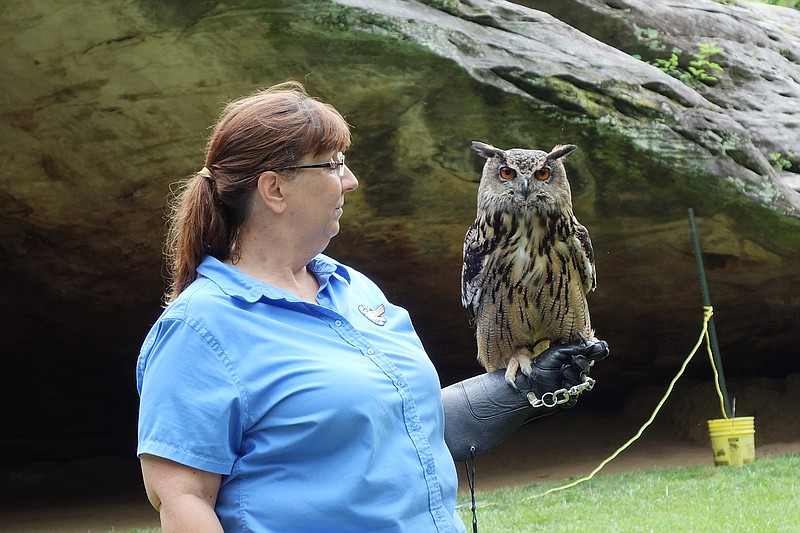DANVILLE, Mo. - Thomas Guillebeau's 10-year love affair with birds began with an injured black vulture on the side of the road.
At the time, Guillebeau was working as a delivery driver and had no experience in bird rehab. During the week, he searched for a wildlife rescue that would accept the vulture, and as he was trying to keep the bird alive, his passion ignited.
He now works for the World Bird Sanctuary in St. Louis, and on Friday, he visited Graham Cave State Park to teach about birds of prey.
"People are more likely to do something when they care about something," he said. "My grandma told me something when I was 6, and it's stuck with me ever since: 'As people, we have the greatest ability to do harm, but also the greatest ability to fix it.'"
And that's important, because birds of prey are in trouble, he said. From big, charismatic birds like eagles and owls to the tiny kestrel, nearly every raptor species across the world is on the decline.
"They're all in trouble," Guillebeau said.
One of the biggest culprits is vehicles. Drivers will carelessly toss food waste out of the car window. That apple core or banana peel attracts bugs and rodents, which in turn lures in birds of prey. WBS frequently receives birds who've been hit by cars. But a car accident is far easier to survive than secondary poisoning, which is when a bird eats a poisoned rodent and is poisoned in turn.
"Snap traps are the better option," Guillebeau said. "There's a reason why people say you can't build a better mousetrap."
Habitat destruction - the paving-over or farming of areas where the birds live and hunt - is also driving population decline, he said.
By sharing interesting info about birds of prey, Guillebeau and his co-presenter, Sandra Lowe, hope to encourage families to get involved in protecting birds of prey.
"Bird of prey" or "raptor" are general terms for a long list of predatory birds: owls, kestrels, kites, eagles, hawks. These birds all have a few things in common, however. They share incredible eyesight; short, sharp, curved beaks; and strong talons.
"A bald eagle can see a fish in the water from a mile away," Guillebeau said.
An owl's eyes take up two-thirds of its skull.
"That sadly means that everything you've ever heard about wise old owls is garbage," he said.
Raptors are the apex predators of the air, with specialized bodies that allow them to pull off some amazing feats. For example, peregrine falcons are the fastest creatures on the planet. They've been clocked diving through the air at 307 mph.
"I always thought cheetahs were faster than anything," said Kayden Barr, 7, who attended the lecture.
Lowe carried peregrine falcon Solo around so everyone could get a look at his razor-sharp talons. Solo was rescued from the wild as an egg after his mother had a run-in with a window. Unfortunately, his egg cooled off somewhat before rescuers could arrive, which caused birth defects including a beak that doesn't line up quite right and curved legs.
"Even healthy falcons will sometimes break a leg when they hit their prey at 300 miles an hour," Guillebeau said. "They need to be able to completely straighten their legs."
Falcons hunt by being faster than anything else, but owls hunt by stealth. They wait in the evening and night for prey to pass by. Their specialized eyes let them see in the dark, and their disc-shaped faces act like "feathered satellite dishes," channeling sounds to their sensitive ears.
Then, they swoop down on silent wings with special, soft feathers. They might not be as fast as a falcon, but they're even more deadly, Guillebeau said.
"Great horned owls are the things that go bump in the night for everything else in the U.S.," he said. "They've killed bobcats and porcupines, and they're the only natural predators of peregrine falcons."
As cool as all these birds are, Guillebeau strongly discouraged trying to acquire a bird of prey as a pet. Aside from requiring some specialized permits, they simply don't make good companions for the vast majority of pet owners.
Owls are the "worst roommates ever," according to Lowe.
They're loud, require a special diet, constant attention and enrichment, and they make a "horrific amount of poop," Guillebeau added.
World Bird Sanctuary specializes in rehabilitating injured birds of prey for re-release or to become ambassador animals. Guillebeau encouraged anyone who finds an injured bird of any kind to call the rescue at 636-225-4390.

